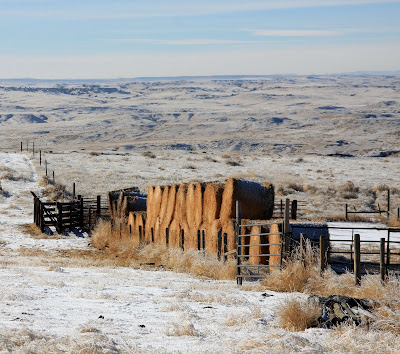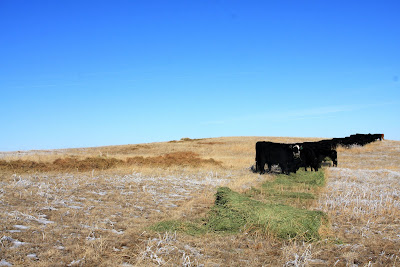Hay like this costs about $65 dollars a ton (a ton is 2,000 pounds). Then you have to pay to have it delivered, which costs about $5 a mile right now. We have our own trucking operation, so that is a little more than we pay, but the offset of paying less in mileage is that we have the time invested in getting it home.
Each of the bales you see in this picture weighs between 1,200 and 1,300 pounds. So, with a little math, you can figure out there is a lot of money sitting in this pen, known as a stack corral.
Stack corrals typically have much higher fences than the average fence to keep out animals like deer, who also love high quality hay.
 I am not involved in the hauling of hay aspect very often. However, next time I am you better believe I will have my camera along, so I can share with you the entire process of getting hay from the field to the cow.
I am not involved in the hauling of hay aspect very often. However, next time I am you better believe I will have my camera along, so I can share with you the entire process of getting hay from the field to the cow. I am more involved in the feeding of the hay to the cows. I stop at the stack corral seen above and pick up one bale of last years hay.
I am more involved in the feeding of the hay to the cows. I stop at the stack corral seen above and pick up one bale of last years hay.If hay is put up (as in cut, and baled) correctly, and stored correctly, it can last for several years. If it isn't put up or stored properly, it can get moldy, and livestock won't eat it, and it becomes useless.
Then I drive about 5 miles to the pasture our cows are in. They know when feed day is, and on my way I turn on a siren briefly to alert them I'm on my way, with breakfast.
They start down the road to meet me, and this is what it looks like.
 So I pull off road to a fairly flat location, and wait for all the cows to get to me.
So I pull off road to a fairly flat location, and wait for all the cows to get to me. Then I unload my bale, until its a few inches off the ground.
Then I unload my bale, until its a few inches off the ground. The net wrapping is cut...
The net wrapping is cut... and pulled off. You want the bale off the ground so you can pull the net wrapping off, and not drag it through a lot of cactus.
and pulled off. You want the bale off the ground so you can pull the net wrapping off, and not drag it through a lot of cactus. Then you drive along, using hydraulic controls to lower the bale as it unrolls on the ground.
Then you drive along, using hydraulic controls to lower the bale as it unrolls on the ground. But this bale was one that I picked up backwards, so in order to get it unrolled I had to back up instead of drive forward. The cows know the drill, and fall in front of the pickup, instead of behind, as their feed is unrolled.
But this bale was one that I picked up backwards, so in order to get it unrolled I had to back up instead of drive forward. The cows know the drill, and fall in front of the pickup, instead of behind, as their feed is unrolled. Once you get out of the way, they all converge on the bale and fill up.
Once you get out of the way, they all converge on the bale and fill up. But these cows get two bales. Their second bale is waiting in another stack corral, in the same pasture as the cows. These bales are second cutting alfalfa, and basically taste like candy to cows. That's why they're set so far away from the fence - to keep the cows from leaning over the fence, and breaking it down, to get a taste.
But these cows get two bales. Their second bale is waiting in another stack corral, in the same pasture as the cows. These bales are second cutting alfalfa, and basically taste like candy to cows. That's why they're set so far away from the fence - to keep the cows from leaning over the fence, and breaking it down, to get a taste. I load one of the tasty bales on the feed pickup...
I load one of the tasty bales on the feed pickup... and head back to the feed grounds, just down the road. We feed in a different location most days so the cows don't tromp down the grass too much. Where we live the soil is highly erosive, and proper soil and plant management is critical in keeping land healthy and in production. If you overuse the land, it shows really fast where I'm from.
and head back to the feed grounds, just down the road. We feed in a different location most days so the cows don't tromp down the grass too much. Where we live the soil is highly erosive, and proper soil and plant management is critical in keeping land healthy and in production. If you overuse the land, it shows really fast where I'm from.A lot of thought goes into even the most seemingly simple task on a ranch.
 I unroll the second bale just like the first. If you ever want to know which of the two, or three, or four bales you just fed is the best, all you have to do is watch which one the cows eat first. You can see that no one is choosing to finish off the first bale I fed with the second one sitting right beside it. This is a pretty obvious example, as the second (green) bale is really really good stuff, and the first one is just kind of average. Sometimes you will have hay you think is very similar, but when you feed two bales, the cows all eat one first, just like what is seen here.
I unroll the second bale just like the first. If you ever want to know which of the two, or three, or four bales you just fed is the best, all you have to do is watch which one the cows eat first. You can see that no one is choosing to finish off the first bale I fed with the second one sitting right beside it. This is a pretty obvious example, as the second (green) bale is really really good stuff, and the first one is just kind of average. Sometimes you will have hay you think is very similar, but when you feed two bales, the cows all eat one first, just like what is seen here.  As I've mentioned before, we feed our livestock to keep them at a certain level of condition. We don't want them too skinny, but it's just as bad, or even worse, to have them too fat. A cow with the right amount of fat will stay healthy, and be strong enough to calve without issues (usually). She also needs to have enough energy stored for when she starts milking, because producing milk takes a lot of energy. Cows that are too fat are much like obese people, they have trouble getting around, and fat deposits in a cows bag can reduce her milking ability.
As I've mentioned before, we feed our livestock to keep them at a certain level of condition. We don't want them too skinny, but it's just as bad, or even worse, to have them too fat. A cow with the right amount of fat will stay healthy, and be strong enough to calve without issues (usually). She also needs to have enough energy stored for when she starts milking, because producing milk takes a lot of energy. Cows that are too fat are much like obese people, they have trouble getting around, and fat deposits in a cows bag can reduce her milking ability.We want our cows to work for us, and instead of getting really fat, we want her to convert that energy to milk for her calf. While there are some parts of the country with so much feed that cows just stay fat, it isn't like that where I'm from. It takes a large area (30-50 acres) to feed one cow for one year where I'm from. People often say that those really big, really fat cows couldn't walk fast enough to get to enough grass to keep them from shriveling up, and it's true.
If a cow does get too skinny after calving, and has used up too much of her energy reserves producing milk, it significantly reduces her chances of re-breeding. Keeping cows near their ideal body condition is a year-round aspect of ranch management, and a critical component of any operation.
All of these cows are in good shape for us, and if the temperature hadn't dropped in the last week we probably would have reduced how much they were getting fed.
 Here are all the cows enjoying their bales of hay. Once they finish off the really good bale, they'll go back and clean up the other bale too. They don't waste feed at our place.
Here are all the cows enjoying their bales of hay. Once they finish off the really good bale, they'll go back and clean up the other bale too. They don't waste feed at our place. Then there is always the second half of any feed day, checking the water to make sure it isn't iced over.
Then there is always the second half of any feed day, checking the water to make sure it isn't iced over. Another benefit of these re-cycled tire tanks is they're black, and absorb more heat due to their color.
One issue we've had with them in the past is that if we installed them prior to getting our sheep (like this one), they're too tall for a sheep to drink out of. When our sheep were in this pasture we would hook up a much smaller tank to the float on this one for the sheep to drink out of.

No comments:
Post a Comment